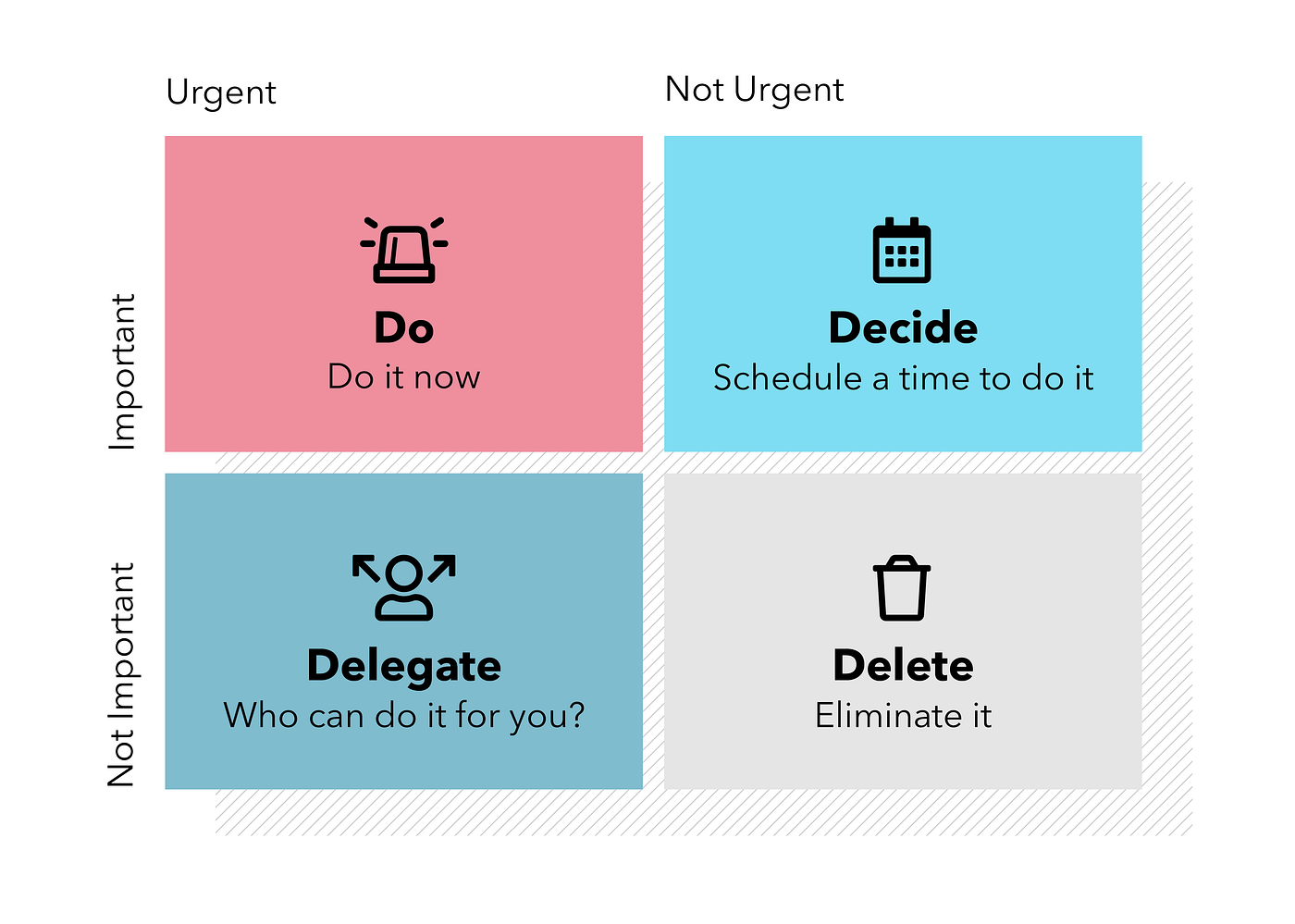How the Urgent-Important Matrix Can Help You Prioritize What Matters
Feeling overwhelmed by your to-do list? Ever catch yourself handling small, urgent tasks only to realize that the important things are getting left behind? Many of us, especially when we first start therapy, struggle with time management and stress, not knowing how to prioritize what truly matters. That’s where the Urgent-Important Matrix, also known as the Eisenhower Matrix, can help.

What is the Urgent-Important Matrix?
Named after U.S. President Dwight D. Eisenhower, who was renowned for his decision-making skills, this matrix is a simple tool designed to help you prioritize your tasks based on their urgency and importance. It breaks tasks down into four clear categories, allowing you to focus on what matters most and let go of unnecessary distractions.
This tool goes by different names, including the Eisenhower Box, the Priority Matrix and the Time Management Matrix.
Despite the different titles, the purpose remains the same: helping you reduce stress and regain control of your time by identifying what really needs your attention.
The Four Quadrants Explained
The Urgent-Important Matrix divides your tasks into four categories, or “quadrants,” based on how urgent and important they are. Let’s break it down:
- Urgent and Important (Do First)
- These tasks require your immediate attention and have serious consequences if delayed. Think of them as crises or essential deadlines that directly impact your well-being or progress.
- Example: A medical emergency, submitting an urgent work report, or preparing for an important meeting.
- Not Urgent but Important (Plan for Later)
- These tasks contribute to your long-term goals and personal growth. They’re important but not time-sensitive, which is why they’re often postponed. However, if ignored for too long, they can become urgent.
- Example: Regular exercise, planning your career development, therapy homework, or scheduling self-care activities.
- Urgent but Not Important (Delegate or Minimize)
- These tasks demand your attention but don’t directly contribute to your personal goals. They can often be delegated or minimized so you can focus on more important things.
- Example: Responding to non-essential emails, attending meetings that don’t require your input, or handling minor interruptions at work.
- Not Urgent and Not Important (Eliminate)
- These are distractions that don’t add value to your life or goals. They waste time and energy and can easily be eliminated or minimized.
- Example: Scrolling through social media mindlessly, binge-watching TV shows, or procrastinating on tasks by doing less important activities.
Why Does the Matrix Work? The Science Behind It
The Urgent-Important Matrix is based on psychological principles that explain why we tend to prioritize urgent tasks over important ones. This phenomenon is called “urgency bias”—our brains are hardwired to give immediate tasks more weight, even if they aren’t as important as long-term goals.
Research in cognitive psychology shows that constantly focusing on urgent tasks can lead to chronic stress and burnout, as we’re always in “reaction mode.” By consciously organizing tasks based on importance, the Matrix helps shift focus from reactive decisions to intentional, well-thought-out actions. This improves mental health, increases productivity, and reduces stress levels over time.
Examples of How the Urgent-Important Matrix Can Work for You
Let’s say you’re balancing work, therapy, and personal life. Here’s how you might organize your tasks using the Matrix:
- Urgent and Important: You have a deadline to complete a project for work, and your therapist has recommended daily mindfulness practice to manage stress. Both are critical, but the work deadline is urgent and needs to be done today.
- Not Urgent but Important: You know you should schedule that annual doctor’s appointment, but it doesn’t need to happen today. This also includes working on therapy homework or creating a self-care routine—important for your well-being, but easy to delay.
- Urgent but Not Important: Your phone buzzes with a group chat notification about dinner plans. This feels urgent, but it’s not critical to your goals. Responding can wait, or you could ask someone else to coordinate the plans.
- Not Urgent and Not Important: You find yourself watching videos on social media that aren’t adding any value to your day. It might feel relaxing, but after an hour, you realize it’s taking time away from more meaningful tasks.
By using the Matrix, you can clearly see where your time and energy are being spent and make conscious decisions about what needs your attention. Over time, this approach helps you build healthier habits and gives you more control over your day.
How to Use the Matrix in Your Daily Life
- Make a list of your tasks: Write down everything you need to get done, whether it’s for work, therapy, or personal life.
- Categorize each task: Use the four quadrants to decide where each task belongs. Ask yourself: Is this urgent? Is it important? Can someone else handle it? Is it a distraction?
- Focus on Quadrant 2 (Not Urgent but Important): This is where real progress happens. By prioritizing long-term goals, self-care, and personal growth, you can prevent future crises and create lasting change in your life.
- Review and adjust: Your priorities will change over time, and that’s okay. Regularly review your tasks and update your matrix to stay on track.
Final Thoughts
The Urgent-Important Matrix isn’t just a tool for managing time—it’s a framework for making intentional choices that support your mental health, productivity, and overall well-being. For those of you just starting therapy, it’s a great way to manage your daily tasks while making space for personal growth and healing.
If you’re feeling overwhelmed by all the demands of life, give the Urgent-Important Matrix a try. It can help you find balance, reduce stress, and ensure that you’re focusing on what truly matters.



